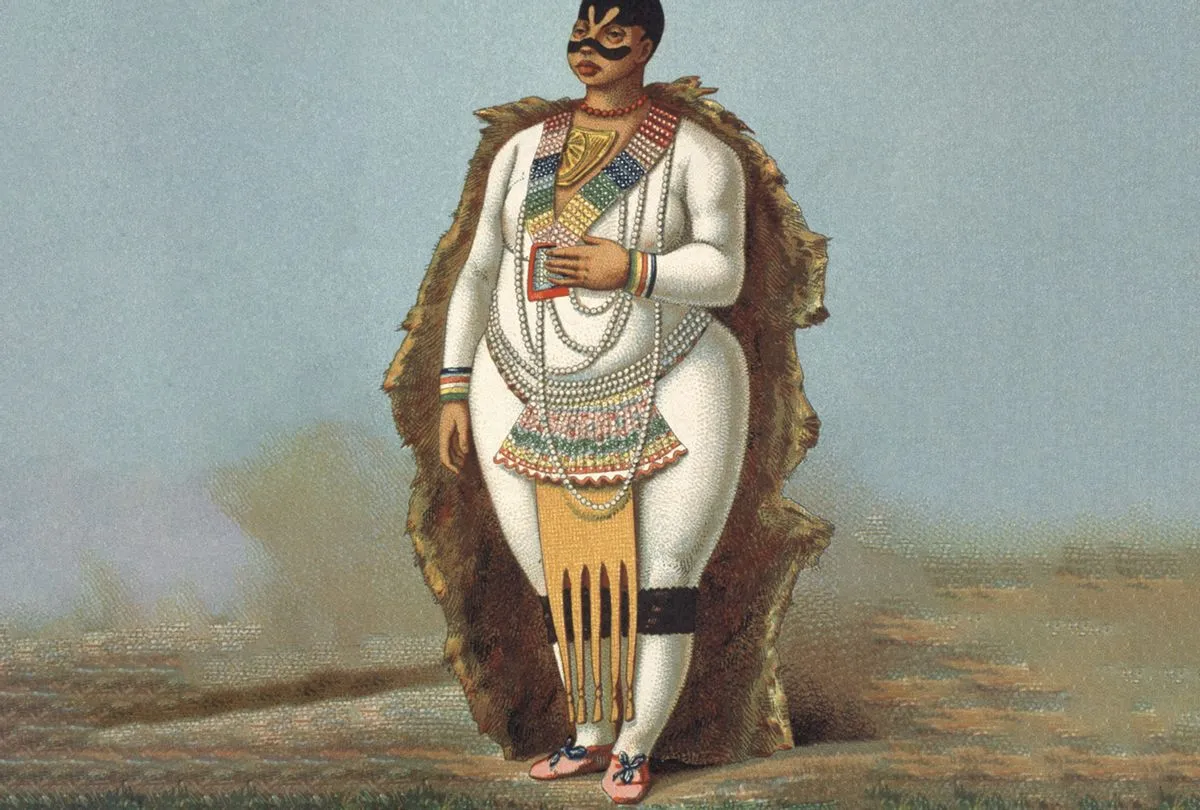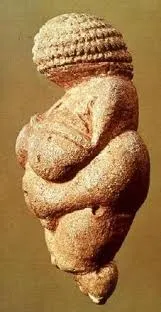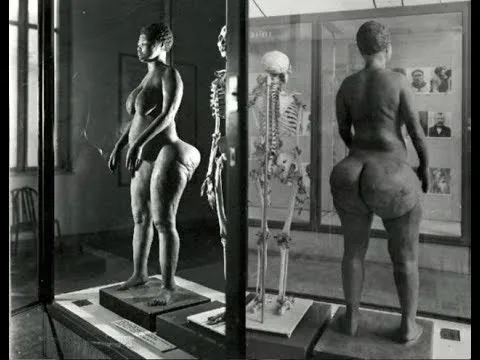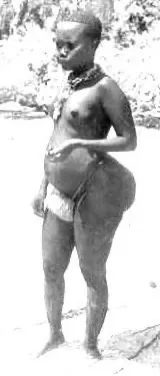
‘Racism in Medical Science and the Sexualization of Black Beauty’ — by the author of ‘The 21st Century Upright Woman’
by Ahimsa Porter Sumchai, MD
“Black Venus” is a 2010 French film based on the life and times of Sarah Baartman. It received the Equal Opportunity Award at the 67th Venice International Film Festival that year. The film maintains a 100% rating on Rotten Tomatoes.
Pygmies and Bushmen once inhabited the African continent “from the Gulf of Aden to the Cape of Good Hope.” For 22,000 years they were the largest group of humans on earth. DNA evidence identifies them as our closest existing link to our ancestral past. Enlightened medical scientists, historians and anthropologists recognize steatopygia as a common trait in early humans.
Steatopygia, from the Greek “steato” meaning fat and “pygia” meaning buttocks, is a unique genetic feature seen in the ancient Khoisan people of southern Africa. In 2013, Chicago native Sarah Massey claimed to have the world’s biggest butt – measuring 7 feet and requiring size 10XL pants.

Cave paintings from Europe created 30,000 years ago display women with large buttocks. A 3,500 year old painted limestone from the 18th Dynasty reign of Queen Hatshepsut on display in the Cairo Antiquity Museum depicts the Queen of Punt on a visit to the Egyptian royal court with an enormous derriere.
“Paris 1816, the Royal Academy of Medicine … I have never seen a human head so similar to that of an ape. Standing by a molded cast of Saartjie Baartman’s body, anatomist Georges Cuvier’s verdict is categorical.
In 1810 Saartjie left her native South Africa accompanied by Hendrik Cesars, who had displayed her at the Cape Town city hospital in exchange for cash. A Scottish military surgeon in the Cape slave lodge named Alexander Dunlop supplied showmen in Britain with exotic animal specimens. Dunlop urged Baartman to travel to Europe to make money exhibiting herself. The group lived together in the most expensive part of London — Duke Street, St. James.
“Free and enslaved at the same time, the Hottentot Venus became an icon in the slums, destined to be sacrificed in the pursuit of a shimmering vision of prosperity.”
Ssehura – aka Saartjie (Sarah) Baartman, was a Khoikhoi woman born near the Gamtoos River in the Xhosa Kingdom of South Africa in 1789 who was exhibited as a freak show attraction in 19th century Europe as the Hottentot Venus. She is believed to be one of four women trafficked to Europe for white entertainment and exhibited for their steatopygia body types that became the subject of scientific debate, the outrage of abolitionists, the erotic projections of Victorian Europe … and the fashion craze of the 19th century.
Baartman’s features were eroticized and described in advertisements as “the most correct and perfect specimen of her race.”
Baartman became the most famous “Hottentot Venus” due to the legal case brought on her behalf by the African Association that detailed key events in her life that remain in the public domain.
According to an affidavit supplied to the Court of King’s Bench British dated Nov. 26, 1810: “Mr. Bullock of Liverpool Museum stated some months since a Mr. Alexander Dunlop, a surgeon in the army, came to him to sell the skin of a camelopard which he had bought from the Cape of Good Hope. Some time after, Mr. Dunlop again called on Mr. Bullock and told him that he had on her way from the Cape a female Hottentot of very singular appearance, who would make the fortune of any person who showed her in London, and that he was under an engagement to send her back in two years.”
A note on a flier written by someone who saw her in London in 1811 includes language from the exhibition. The 1807 Slave Trade Act abolished the slave trade and a British abolitionist society, the African Association, sponsored a newspaper campaign describing the cage in which Baartman was exhibited and evidence she was being coerced. Marketed as the “missing link between man and beast,” in her 1810 London appearance Baartman wore a tight fitting garment, feathers and tribal ornaments. She did not appear nude.
The African Association filed a civil action at the Court of King’s Bench calling for the attorney general to liberate her. On Nov. 24, 1810, Baartman was questioned in Dutch, in which she was fluent, and according to a 2008 article in a British journal titled “Race and Erasure”:
In 1814 Baartman traveled to Paris where she was publicly displayed and became the subject of racially derogatory caricatures. She attracted the attention of anatomist Georges Cuvier, famous for comparing racial types who viewed her as an example of a primitive human. Following the fall of Napoleon in 1814, France reigned in a highly conservative fashion and Baartman was sold to S. Reaux, an exhibitor and animal trainer. She was sexually abused by patrons “willing to pay for her defilement.” One year later she was dead.

Steatopygia and science
The human butt interests me, as it does most people, but not because it symbolizes eroticism and sexual appeal. The most impressive analysis of the human derriere is the Smithsonian documentary “Big Butts Loose Shoulders” that scientifically analyzes the role of the buttocks as a pure running adaptation. The gluteus maximus is the largest muscle in the human body. It is a defining feature of the genus homo sapien.
In the article, “The Human Spine is like a Precious Strand of Pearls,” published in the Journal of Women’s Health Care in 2012, I expound on the evolution of the upright bipedal spine and the role it plays in low back pain and the lumbar spine degeneration evident in skeletal remains of human ancestors as old as Lucy.
Discovered in the Afar Region of Ethiopia in 1974, Lucy was short, had a small brain and gathered berries, nuts, insects and eggs from unguarded nests about 3.2 million years ago. Her most striking physical features are a valgus knee and a lumbar curve — signs of habitual bipedalism.
If the question is whether there are evolutionary advantages to having a ginormous butt, the answer is yes.
Author Martin Oghigian answers the explosive question posed on the website Quora, “Why do Black girls have bigger hips and booty than girls of other races?”
“They also tend to have larger breasts. This is largely because Africa was, and still is a hot place, and the more surface area on the body, the easier it is to expel heat. This is also the reason why Blacks tend to have longer arms and legs and smaller torsos. Conversely whites, especially northern whites, have larger torsos, broader frames and shorter limbs making them more compact to conserve heat.”
Steatopygia, the storage of excessive calories as fat in the hips and butt, creates a build in which fat is not confined to the gluteal region but extends to the outside and front of the thighs and tapers to the knee producing a curvaceous figure that clearly offers evolutionary advantages in attracting a mate.

The accentuated lumbar lordosis – also called hyper lordosis or “swayback” – is a common variation in human anatomy in which the spine and pelvis are pushed forward creating a large curve in the back. Lordosis is associated with an increased prevalence of vertebral compression fractures, spinal degeneration and low back pain.
A Hottentot woman with prominent buttocks “Due to an Abnormal Amount of Fat” is an unframed art print created by an unknown artist in the Wellcome Collection. While it exaggerates the amount of steatopygia Sarah Baartman actually displayed, it also identifies that the buttock shape is not solely due to fat accumulation. The lumbar spine curves into a shelf at a near 90 degree angle accentuating the prominence of the derriere.
Sarah Baartman died on Dec. 29, 1815, of undetermined causes. She was 27 years old. Within 24 hours of her death, police released her body to Georges Cuvier, a French naturalist and zoologist. According to Wikipedia, Cuvier conducted racial studies that provided the foundation for scientific racism and published work on differences between racial groups’ physical and mental abilities. Cuvier subjected Sarah Baartman to examinations while held captive in a state of neglect.
“Cuvier’s dissection of Baartman helped shape European science and the theory that African women were savage and distinct from the “civilized females” of Europe. “Her skeleton, genitals and brain were displayed in the Paris’ Musee de l’Homme until 1974 as evidence of “her sexual primitivism and intellectual equality with that of an orangutan.”
Calls for the return of Sarah Baartman’s remains began in the 1940s. A poem written by Diana Ferrus – a poet of Khoisan descent – entitled “I’ve come to take you home” became the rallying cry for the movement to return Sarah Baartman to her South African motherland. The case garnered worldwide attention in the 1980s with publication of the book “The Hottentot Venus.”
Following the victory of the African National Congress in the 1994 South African general election, President Nelson Mandela formally requested France return her remains. On March 6, 2002, the French National Assembly agreed to the request.
Ssehura returned to the Gamtoos Valley on May 6, 2002. She was buried on a hill in the Eastern Cape 200 years after her birth. A refuge for survivors of domestic violence, the Saartjie Baartman Centre for Women and Children opened in Cape Town in 1999.
Sarah Baartman was buried on Aug. 9, 2002 – Women’s Day – a public holiday in South Africa.
“I’ve come to take you home
I’ve come to take you home-home, remember the veld? the lush green grass beneath the big oak trees, the air is cool there and the sun does not burn.
I have made your bed at the foot of the hill, your blankets are covered in buchu and mint, the proteas stand in yellow and white and the water in the street chuckle sing-songs as it hobbles along over little stones.
I have come to wretch you away — away from the poking eyes of the man-made monster who lives in the dark with his clutches of imperialism who dissects your body bit by bit, who likens your soul to that of Satan and declares himself the ultimate god!
I have come to soothe your heavy heart, I offer my bosom to your weary soul, I will cover your face with the palms of my hands, I will run my lips over lines in your neck, I will feast my eyes on the beauty of you and I will sing for you … for I have come to bring you peace.
I have come to take you home, where the ancient mountains shout your name. I have made your bed at the foot of the hill, your blankets are covered in buchu and mint, the proteas stand in yellow and white —
I have come to take you home where I will sing for you
for you have brought me peace
for you have brought us peace.”
Dr. Ahimsa Porter Sumchai is author of “The 21st Century Upright Woman — Low Back Pain and the Evolution of the Bipedal Spine.” In 1981, Dr. Sumchai made history as the first African American woman to train in neurological surgery in the University of California system after being accepted in the Department of Neurological Surgery at both the University of California San Diego and the University of California at San Francisco.





